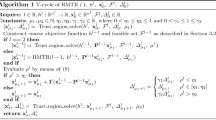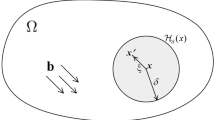Abstract
We use the graphical processing unit (GPU) to perform dynamic fracture simulation using adaptively refined and coarsened finite elements and the inter-element cohesive zone model. Due to the limited memory available on the GPU, we created a specialized data structure for efficient representation of the evolving mesh given. To achieve maximum efficiency, we perform finite element calculation on a nodal basis (i.e., by launching one thread per node and collecting contributions from neighboring elements) rather than by launching threads per element, which requires expensive graph coloring schemes to avoid concurrency issues. These developments made possible the parallel adaptive mesh refinement and coarsening schemes to systematically change the topology of the mesh. We investigate aspects of the parallel implementation through microbranching examples, which has been explored experimentally and numerically in the literature. First, we use a reduced-scale version of the experimental specimen to demonstrate the impact of variation in floating point operations on the final fracture pattern. Interestingly, the parallel approach adds some randomness into the finite element simulation on the structured mesh in a similar way as would be expected from a random mesh. Next, we take advantage of the speedup of the implementation over a similar serial implementation to simulate a specimen whose size matches that of the actual experiment. At this scale, we are able to make more direct comparisons to the original experiment and find excellent agreement with those results.















Similar content being viewed by others
References
Alhadeff A, Celes W, Paulino GH (2015) Mapping cohesive fracture and fragmentation simulations to GPUs. Int J Numer Methods Eng 103:859–893. doi:10.1002/nme.4842
Kirk DB, Wen-mei WH (2010) Programming massively parallel processors: a hands-on approach. Morgan Kaufmann, San Francisco
Brodtkorb AR, Hagen TR, Sætra ML (2013) Graphics processing unit (GPU) programming strategies and trends in GPU computing. J Parallel Distrib Comput 73(1):4–13
Dziekonski A, Sypek P, Lamecki A, Mrozowski M (2012) Generation of large finite-element matrices on multiple graphics processors. Int J Numer Methods Eng 94(2):204–220
Cecka C, Lew AJ, Darve E (2010) Assembly of finite element methods on graphics processors. Int J Numer Methods Eng 85(5):640–669
Wang L, Zhang YS, Zhu B, Xu C, Tian XW, Wang C, Mo JH, Li J (2012) GPU accelerated parallel cholesky factorization. Appl Mech Mater 148–149:1370–1373
Dooley I, Mangala S, Kale L, Geubelle P (2008) Parallel simulations of dynamic fracture using extrinsic cohesive elements. J Sci Comput 39(1):144–165
Lawlor OS, Chakravorty S, Wilmarth TL, Choudhury N, Dooley I, Zheng G, Kalé LV (2006) ParFUM: a parallel framework for unstructured meshes for scalable dynamic physics applications. Eng Comput 22(3–4):215–235
Radovitzky R, Seagraves A, Tupek M, Noels L (2011) A scalable 3D fracture and fragmentation algorithm based on a hybrid, discontinuous Galerkin, cohesive element method. Comput Methods Appl Mech Eng 200(1–4):326–344
Espinha R, Park K, Paulino,GH, Celes W (2013) Scalable parallel dynamic fracture simulation using an extrinsic cohesive zone model. Comput Methods Appl Mech Eng 266(C):144–161
Park S, Shin H (2012) Efficient generation of adaptive Cartesian mesh for computational fluid dynamics using GPU. Int J Numer Methods Fluids 70(11):1393–1404
Dugdale D (1960) Yielding of steel sheets containing slits. J Mech Phys Solids 8(2):100–104
Barenblatt GI (1962) The mathematical theory of equilibrium cracks in brittle fracture. Adv Appl Mech 7(55–129):104
Park K, Paulino GH, Roesler JR (2009) A unified potential-based cohesive model of mixed-mode fracture. J Mech Phys Solids 57(6):891–908
Park K, Paulino GH (2011) Cohesive zone models: a critical review of traction-separation relationships across fracture surfaces. Appl Mech Rev 64(6):060802
Camacho G, Ortiz M (1996) Computational modelling of impact damage in brittle materials. Int J Solids Struct 33(20–22):2899–2938
Newmark NM (1959) A method of computation for structural dynamics. J Eng Mech Div 85(7):67–94
Boyalakuntla DS, Murthy JY (2002) Hierarchical compact models for simulation of electronic chip packages. Compon Packag Technol IEEE Trans 25(2):192–203
Ducros F, Ferrand V, Nicoud F, Weber C, Darracq D, Gacherieu C, Poinsot T (1999) Large-eddy simulation of the shock/turbulence interaction. J Comput Phys 152(2):517–549
Fryxell B, Olson K, Ricker P, Timmes FX, Zingale M, Lamb DQ, MacNeice P, Rosner R, Truran JW, Tufo H (2000) FLASH: An adaptive mesh hydrodynamics code for modeling astrophysical thermonuclear flashes. Astrophys J Suppl Ser 131(1):273
Celes W, Paulino GH, Espinha R (2005) A compact adjacency-based topological data structure for finite element mesh representation. Int J Numer Methods Eng 64(11):1529–1556
Welsh DJ, Powell MB (1967) An upper bound for the chromatic number of a graph and its application to timetabling problems. Comput J 10(1):85–86
Park K, Paulino GH, Celes W, Espinha R (2012) Adaptive mesh refinement and coarsening for cohesive zone modeling of dynamic fracture. Int J Numer Methods Eng 92(1):1–35
Velho L, Gomes J (2000) Variable Resolution 4-k Meshes: Concepts and Applications. Comput Graph Forum 19(4):195–212
Bishop JE (2009) Simulating the pervasive fracture of materials and structures using randomly close packed Voronoi tessellations. Comput Mech 44(4):455–471
Sharon E, Fineberg J (1996) Microbranching instability and the dynamic fracture of brittle materials. Phys Rev B Condens Matter Mater Phys 54(10):7128–7139
Zhang ZJ, Paulino GH, Celes W (2007) Extrinsic cohesive modelling of dynamic fracture and microbranching instability in brittle materials. Int J Numer Methods Eng 72(8):1017–1048
Paulino GH, Park K, Celes W, Espinha R (2010) Adaptive dynamic cohesive fracture simulation using nodal perturbation and edge-swap operators. Int J Numer Methods Eng 84(11):1303–1343
Spring DW, LeonSE, Paulino GH (2014) Unstructured polygonal meshes with adaptive refinement for the numerical simulation of dynamic cohesive fracture 189(1):33–57
Miller O, Freund LB, Needleman A (1999) Energy dissipation in dynamic fracture of brittle materials. Model Sim Mater Sci Eng 7(4):573
Zhang Z (2007) Extrinsic cohesive modeling of dynamic fracture and microbranching instability using a topological data structure, Ph.D. thesis
Acknowledgments
Andrei Alhadeff and Waldemar Celes thank the support provided by the Tecgraf Institute at PUC-Rio, which is mainly funded by the Brazilian oil company, Petrobras. They also thank the Brazilian National Council for Scientific and Technological Development (CNPq) for the financial support to conduct this research. Sofie E. Leon and Glaucio H. Paulino gratefully acknowledge the support of the Philanthropic Education Organization (PEO) Scholars Award, and the Raymond Allen Jones Chair endowment at the Georgia Institute of Technology, respectively. They also acknowledge the support of the National Science Foundation (NSF) through grants CMMI #1321661 and CMMI #1437535.
Author information
Authors and Affiliations
Corresponding author
Additional information
Andrei Alhadeff and Sofie E. Leon equally contributed to this work.
Rights and permissions
About this article
Cite this article
Alhadeff, A., Leon, S.E., Celes, W. et al. Massively parallel adaptive mesh refinement and coarsening for dynamic fracture simulations. Engineering with Computers 32, 533–552 (2016). https://doi.org/10.1007/s00366-015-0431-0
Received:
Accepted:
Published:
Issue Date:
DOI: https://doi.org/10.1007/s00366-015-0431-0




